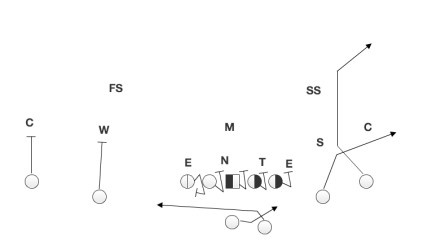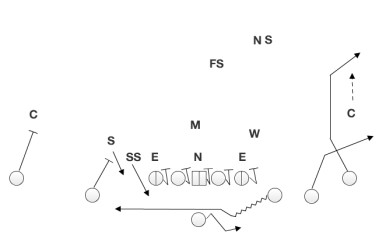“Stretching the field” is a phrase offensive coordinators everywhere are fond of using, but few teams commit to it like Oregon. If there’s one thing we know about Oregon’s offense, it’s that the Ducks never seem to run out of ways to move the football around and utilize all 53 1/3 yards of the width of the field. Offensive Coordinator Scott Frost and this Oregon staff may not have invented the idea of the packaged play, sometimes referred to as a run-pass option, but they definitely make good use out of it on a regular basis, and today we’re going to take a closer look at one way to use it.
In this article, we’re going to go in-depth in one particular concept, an inverted zone read packaged with a pass play, and take a look at two different examples, one run to the perimeter, and one pass to the opposite side of the formation.
Play #1 – vs Ohio State – 14:48 4th Quarter – 1st & 10 on the -41 yard line

Depending on how the defensive end reacts, this could end up as either a run to the perimeter or a pass to the flat.
The first play is taken from the National Championship game a few months back. The Ducks had been struggling to find ways to get the ball on the edge all game, but at this point early in the 4th quarter, they were only eight points down.
Ohio State gives them the same defensive look they’ve been giving them all game long, a five man box with the defensive line shifted toward the lone back in the backfield to the right of Mariota.

It’s a 4-1 look inside, with four down linemen and one linebacker aligned over the center. This has been a consistent look from the Buckeye defense all game against this formation.
At the snap, Mariota’s eyes go to the defensive end lined up head up over the left tackle. The end does his best to come down the line and stay engaged with the left tackle, so as a result Mariota hands the ball off to the back and gives him a chance to get to the perimeter.
Unfortunately for Oregon, the tight end lined up in the slot is absolutely destroyed by the outside linebacker who comes up to make the play on the run to the outside. This is partly because he’s already off balance by the time he makes contact with the defender, and also because he has to let the defender come to him.
One of the tricky things about blocking on the perimeter on these packaged plays is that most of the time, even the skill players on offense don’t know whether it’s going to be a run or a pass until the quarterback makes the decision. In other words, if the slot receivers to one side of the formation fly down the field to block the first man they see wearing an opposite color jersey, and Mariota ends up throwing the backside flat route, it’s a penalty for offensive pass interference, and the offense has to back up ten yards.
Even though the play doesn’t end up as planned in this instance, the offense has the numbers on the edge and it’s still a great way to stretch the field horizontally.
Play #2 – vs Florida State – 7:09 3rd Quarter – 2nd & 6 on the -37 yard line
Now we come to the second half of the play, where the defense does a good job of taking away more than half of the football field with an aggressive blitz off the edge from the field side of things. A few months ago I wrote about Florida State’s affinity for bringing pressure from all directions, and this play is no different. Their 3-safety personnel package gives them a lot of flexibility when it comes to blitz schemes and the coverages behind them.

The pre-snap look from the defense gives Mariota a pretty good idea of the edge pressure that will be coming.
At first Oregon lines up in an empty set with three receivers aligned into the boundary, then moments before the snap he motions the tailback originally lined up in the slot back into the backfield. The defense is pretty clear with their intentions here, not only having multiple defenders up on the edge, but also adjusting things on the back end so that everything matches up. Notice that the two deepest safeties in the above photo are aligned outside the right hash and are set up to take away any deep or intermediate throws to the short side of the field, which is where Oregon has done a lot of damage in this game.
The strategy here involves bracketing the short side of the field and outnumbering the offense in pass coverage so that only the shortest throws have a possibility of being completed.
Believe it or not, this is a really great look for the offense, simply because it means that there isn’t a lot of thinking involved for Mariota. In other words, unless there’s something completely unexpected at the snap where the defense completely backs off from their aggressive alignment, there’s a 99% chance this play is going to be a pass into the boundary side.
The pass concept is set up as a pretty standard rub to get the inside receiver open underneath in the flat, and Mariota should get the ball to the slot receiver as soon as he sees him start to come open. It should also be noted that the break to the flat by the slot receiver is almost perfectly timed up so that once Mariota comes off the mesh point in the backfield and turns his shoulders to face the boundary, his primary receiver should be coming open at just that instant.
The play doesn’t end up picking up more than a few yards, but the point is that the offense has found a way to systematically attack the entire width of the field with relatively little risk, and better yet, the defense allows them to play even faster by simplifying the read.
Conclusion
This is another example of a simple play design, and by extension, a way to get your players to play faster. The thing that often gets lost in conversations about X’s and O’s is that when the defense gets very aggressive and puts their cards on the table so to speak, in a lot of ways it can make things easier for an offense, just because they eliminate a lot of the decisions that an offense has to make, meaning that the players can just play, and at the end of the day that will win you a lot of football games.
It’s also important to recognize that even though these plays didn’t result in big gains, that the scheme has answers already built-in just in case the defense decides to bring something unexpected. In that way, the offense doesn’t have to make a lot of adjustments, the quarterback just needs to know the progression and the play can continue on schedule.
Want more from Life After Football including free playbooks, exclusive content, and more?
Sign up below and get access to all kinds of great coaching materials. It’s completely free and always will be.
